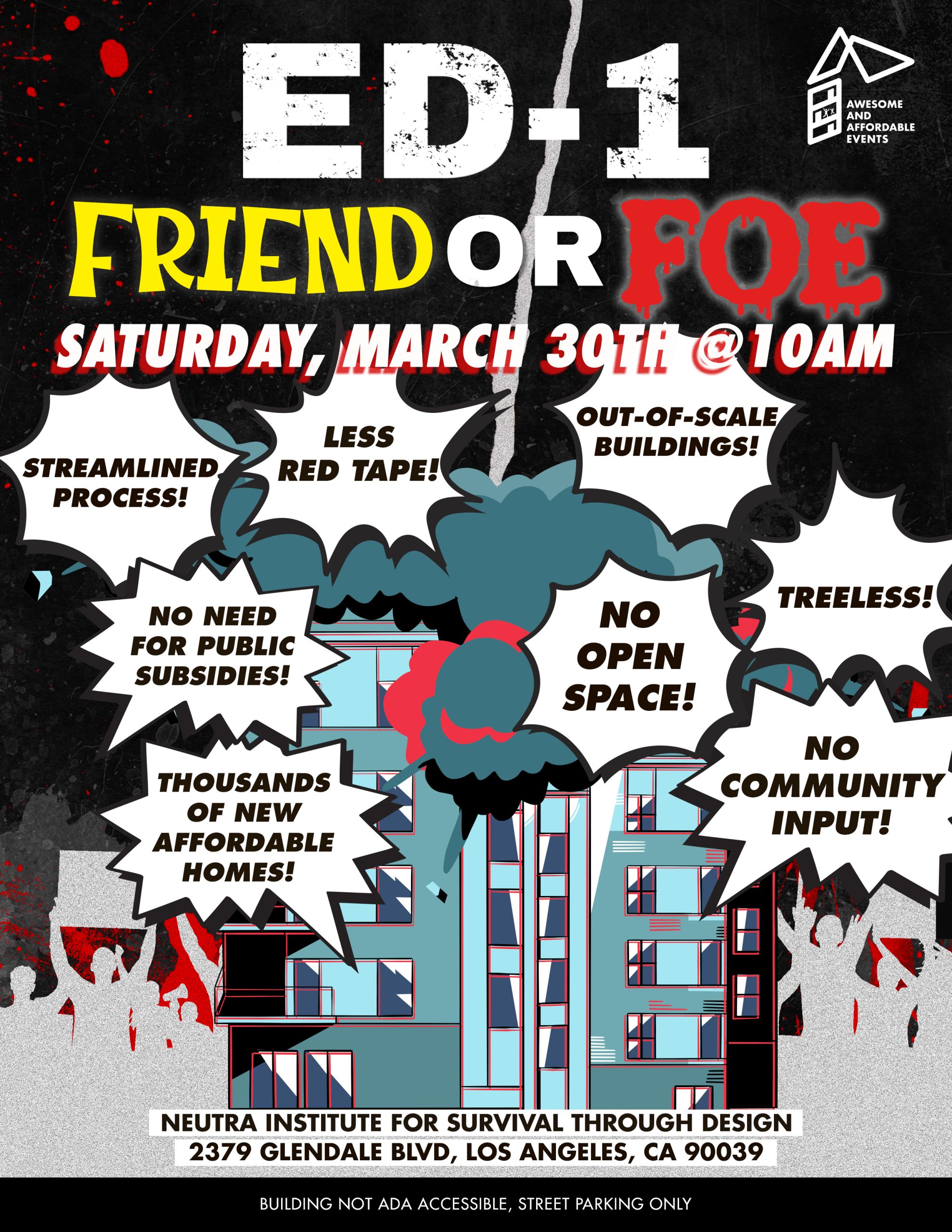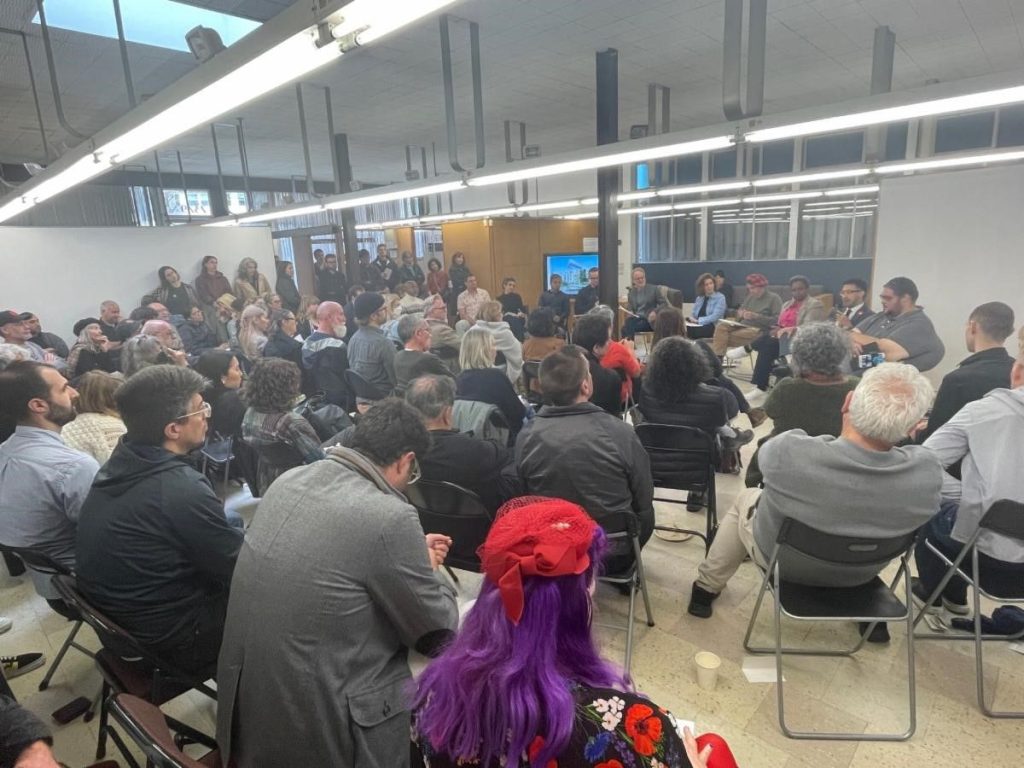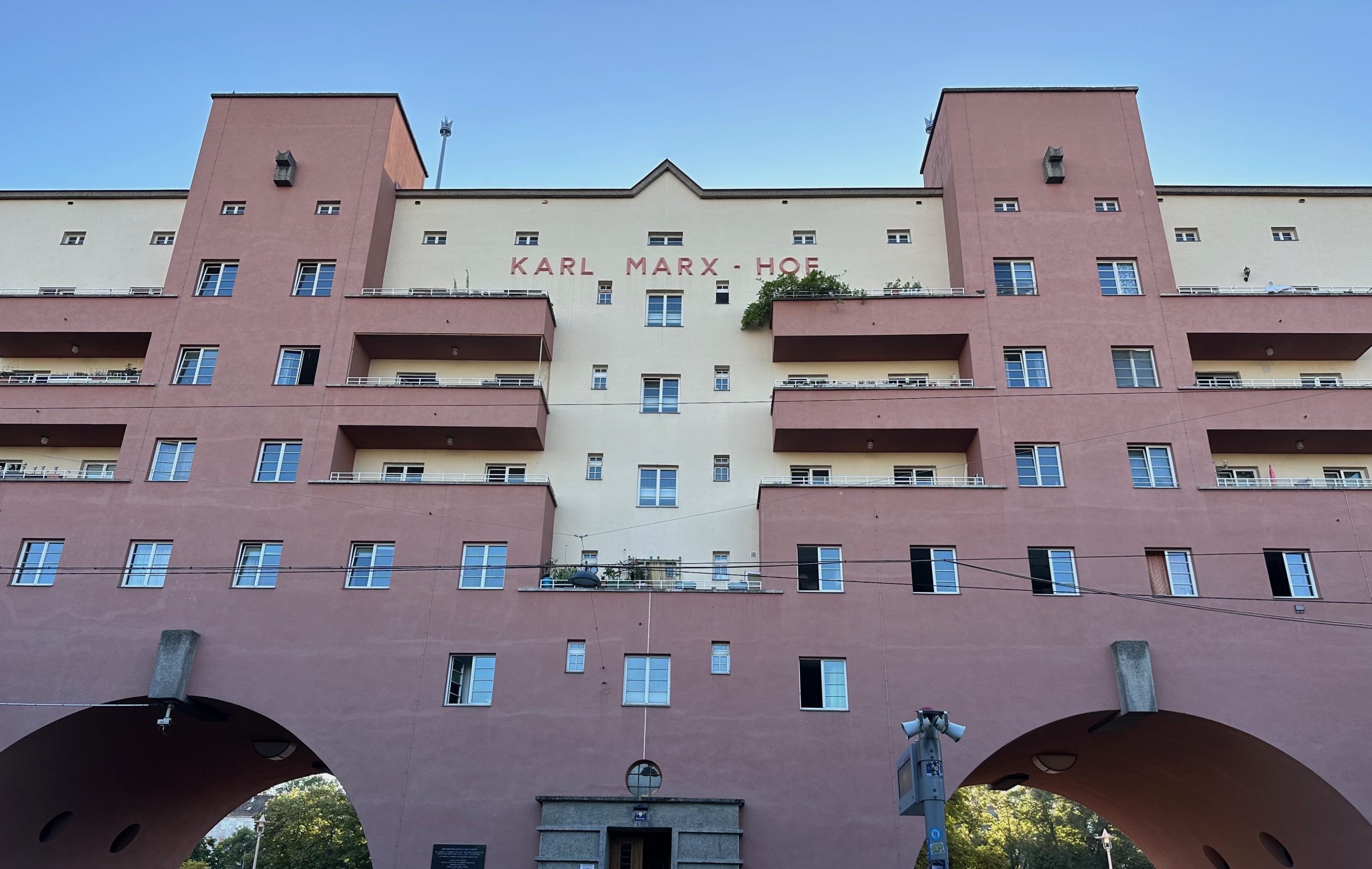Events
ED-1: Friend or Foe?

The Conversation
The housing shortfall in Los Angeles, especially for low and very low-income people, is so huge that local and state elected officials have gotten serious about expediting more construction. On her first day in office, Mayor Karen Bass issued Executive Directive 1 or ED1. This would streamline the approval process for 100% affordable housing projects, cut red tape and the community input that can tie up housing projects in endless review and litigation.
Taken in combination with state density bonuses, ED1 has been a game changer. It has stimulated the entitling of thousands of 100% affordable dwellings, the majority by private developers, obviating the need for taxpayer subsidies. However, as the rubber starts to hit the road, some less positive or unexpected impacts are emerging, having to do with quality, equity, livability — and affordability!

On a wet Saturday morning at the end of March, 150 people braved the rain to attend ED 1: Friend or Foe, a public conversation hosted by FORT:LA about the implications of Mayor Karen Bass’ Executive Directive 1 (ED1). Eight housing stakeholders shared their expertise on the affordability, livability and impact on the cityscape of apartments approved under ED1. They did so in an exchange, moderated by Frances Anderton and David Kersh, that proved by turns feisty, passionate, informative, as well as clarifying about the sheer complexity of the housing challenge in Los Angeles.
There was an added urgency to the event, the second in a series hosted as part of FORT’s Awesome and Affordable project, because the City Council is currently in the process of codifying ED1 into the LA municipal code, to be named the Affordable Housing Streamlining Ordinance, and the public has been weighing in on a draft Ordinance. Moreover, as this Ordinance is going through the process, two councilmembers have introduced separate motions to address growing concerns related to ED1 project impacts on existing rent-controlled units as well as on Historical Preservation Overlay Zones (HPOZ).
Read on for some of the takeaways from the conversation.
Streamlined Process Helps!
ED1 was issued by the Mayor upon taking office in a bid to alleviate LA’s dire lack of affordable housing, and in short order, the directive has enabled some 13,000 OR 16,000 new housing units to be entitled, a pace unheard of in years. Vijay Sehgal, Partner, FSY Architects, and designer of three projects approved under ED1, told the crowd that in the past it could take six to ten years to get a project from a client’s first call to the ribbon cutting. With ED1, “from start of entitlements to start of construction, it was 14 months, and that’s the fastest I’ve seen in affordable housing.”
New Players: Private Developers Who Don’t Use Public Subsidies
The directive streamlines the planning and permitting process and, in addition, lets developers use density, height, set backs, parking and design incentives and waivers from the State Density Bonus law. ED1 was targeted at nonprofit developers of 100% affordable, subsidized housing, but unexpectedly attracted the attention of private developers, like Andrew Slocum, Principal, Green Development Company. “We saw that it was a way for the private sector to address a social issue that we all have: housing. And to get rid of some of the bureaucratic red tape that’s associated with taking subsidized public dollars.” Relative to the 600,000 – million dollars per unit cost in tax credit based AH, Slocum said, “our all-in project costs around $200,000 per unit. That is not because it’s a substandard unit, or because it’s cheaper building materials. It’s because we don’t have to have a team of lawyers, we aren’t taking a 10% development fee. We don’t have to adhere to all of the standards that subsidized dollars have to.”
But ED1 May Not be Good for Low-Income Tenants with Rent-Controlled Apartments
However, these projects pencil for private developers if they are aimed at people earning from 80 – 120% of median income, which is not the 30 – 60% bracket achievable with tax credits. So some housing experts believe that ED1 projects will end up replacing existing, smaller rent stabilized apartments, displacing their occupants. Greg Goldin, a homeowner association president and co-author of Phaidon Atlas of Never Built Architecture, cited a specific ED1 project in Echo Park, a multistory, studio filled building proposed at 4319 Toland Ave. “It’s a completely, wildly out-of-scale building. But most importantly, there are 50 residents in that building living under rent control, who are going to be booted out, they’re going to be evicted, they will be displaced.”
Yes, More Units But Concerns About Location
Several speakers gave big props to Mayor Bass for stimulating supply with ED1 but worried that most of the new apartment buildings would be located on thoroughfares in low economic opportunity neighborhoods, perpetuating segregation and poverty.
The affordable housing developer Rochelle Mills, President & CEO, Innovative Housing Opportunities (IHO), said her concern is that the deepest affordability will be “concentrated in communities of color,” and invoked the poster child for the failures of public housing: “I look at it as Pruitt Igoe horizontal, all the way down the Crenshaw corridor. Why I have a problem with that is that we’re not encouraging the kind of mix of incomes that creates the kind of vibrancy and vitality that attracts the resources. I don’t think it was intended to be that myopic. But the road to hell is paved with good intentions.”
ED1 Shouldn’t Exempt R1 Zones
Single family neighborhoods (R1) are exempt from ED1 projects, and that undermines the spirit of the directive, in the view of some speakers. Joshua Gonzales, Education Director, Abundant Housing, also believes ED1 increases supply, but says, “Abundant Housing LA’s mission is to address the housing crisis, and to address all of the exclusionary land policies that have been implemented over the last century. Exempting R1 single family homes, that’s not okay.”
Concerns About Size, Design, Livability, Light
Not only would single family neighborhoods be off limits to ED1 projects but ED1 buildings may be off limits to many working families. Eduardo Mendoza, Policy Director, Livable Communities Initiative (LCI), also supported the ordinance for streamlining supply, but observed that many of the units it would deliver would not be for working families most in need. That is because the majority of privately funded ED1 projects comprise studios and one bedrooms, he pointed out. He added that they also fall short in terms of livability and quality of life as well, lacking open space, tree canopy and natural light. “In a great chunk of units being built in these nice developments, the bedrooms have no windows. When you build on a single parcel, all your units must face the side of a building. When you’re building an eight storey building, you’re living in a unit in perpetual darkness.”
Who Should be in Charge of Open Space?
While some speakers believed good design and planning would resolve these problems outlined by Mendoza, others argued that this new era of ED1 housing construction on thoroughfares requires a new, less privatized approach to each project, and deeper municipal investment in the shared civic space, in tree canopy and improved sidewalks and open space. Shane Phillips, author of The Affordable City: Strategies for Putting Housing Within Reach (and Keeping it There) noted that the city “has to become denser for affordability reasons, for sustainability reasons, for mobility reasons,” and “as we move toward that we really need to be thinking about the planning of public space.”
Is ED1 a Bandaid that Fails to Reach the Scale of the Problem?
The role of the public sector was a recurring theme throughout the dialogue – from planting trees to investment in housing at scale. In a searing summary statement Rachel Allen, Principal, RADAR/Senior Fellow, LA Metro made the case that ED1 was essentially a bandaid over a gaping wound, a wound that has enlarged over the decades as the government has pulled back from investing in housing. “We’re not operating at the scale of the problem,” said Allen, adding “ED1 is what you get when you have reduced the people who can solve your problem to developers and housing as a commodity. It’s the tool that you get when you’ve backed yourself into a corner.”
ED1: Friend or Foe hammered out ideas on a complex policy shaping the future of our housing, streets and neighborhoods. Beyond just delving into this specific policy, the differing perspectives illuminated the tensions, concerns, opportunities and challenges about the growth of Los Angeles and its future. It shed light on the give and take involved in addressing our housing challenges. The recognition that there are no simple answers, or of a one-size-fits-all solution. And it allowed a packed room of engaged attendees to see the interplay of the interests and voices from those involved in shaping the city: advocacy, research, labor, social justice, community groups; design experts; and private and non-profit developers.
And it ended on a hopeful note. “It is not a panacea,” noted Mills. “There’s just not going to be one size fits all. I’m saying that there are lots of opportunities for us to share the pain and then to end up in a more beautiful equitable housing landscape.”
Speakers
Rachel Allen, Principal, RADAR/Senior Fellow, LA Metro
Greg Goldin, journalist and co-author, Never Built Los Angeles; Phaidon Atlas of Never Built Architecture
Joshua Gonzales, Education Director, Abundant Housing
Eduardo Mendoza, Policy Director, Liveable Communities Initiative (LCI)
Rochelle Mills, President & CEO, Innovative Housing Opportunities (IHO)/Boardmember, Housing California
Shane Phillips, Author, The Affordable City: Strategies for Putting Housing Within Reach (and Keeping it There)/Manager, Randall Lewis Housing Initiative for the UCLA Lewis Center for Regional Policy Studies
Vijay Sehgal, Partner, FSY Architects
Andrew Slocum, Principal, Green Development Company
Moderators
Frances Anderton, co-author, Awesome and Affordable: Great Housing Now; author, Common Ground: Multifamily Housing in Los Angeles
David Kersh, co-author, Awesome and Affordable: Great Housing Now
Relevant Articles
CalMatters: Los Angeles’ one weird trick to build affordable housing at no public cost
Bloomberg: Los Angeles Seeks Speedier Way to Build New Affordable Homes
Los Angeles Times/Opinion: Don’t gut L.A.’s best shot at building affordable housing
Los Angeles Times/Opinion: Who gets to live in L.A? A bold plan to create affordable housing has a serious flaw
LAIst.com: Environmental Reviews Are Holding Up New Affordable Housing In LA, Despite Mayor’s Promise
LA Daily News: Loophole lets developers put big apartment buildings next to SF Valley houses
The Real Deal: Projects Multiply in LA as Developers Question The Math
Housing Vienna: Lessons for Los Angeles
